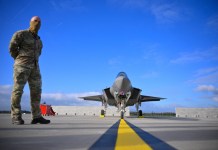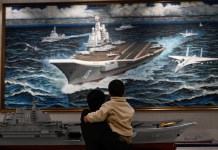The Royal Australian Air Force (RAAF) received the delivery of its 44th F-35A 5th-gen fighter jet from the United States last week, seen as an important milestone in strengthening the service.
Australia is one of the three nations equipped with the F-35 in the Eastern Pacific, the other two being Japan and South Korea.
The latest delivery included three aircraft, added to the 77th Squadron of RAAF. The aircraft flew from Elgin Air Force Base in Florida, and landed at RAAF base Williamtown, via the Hickam Air Force Base in Hawaii.
The aircraft, as part of the 77th squadron, also participated in exercise Lightning Spear 21 at Elgin base from November 1 to 5 before departing for Australia.
“The consecutive activities of Lightning Spear and Lightning Ferry demonstrates No. 77 Squadron’s agility and maturity at operating with our latest F-35A capability,” Commanding Officer No. 77 Squadron Wing Commander Tim Ireland said.
“The F-35A is the seventh fighter that No. 77 Squadron has operated. It’s humbling to be a part of such a significant phase of our proud 79-year history,” he added.
Australia has ordered a total of 72 F-35A fighter aircraft, and the first airframe was delivered in 2014. There was a consideration that Canberra might order F-35B STOVL variants, however, this proposal was rejected due to the high costs of modifications to serving vessels.

Difference Between F-35A/B/C Variants?
The F-35 is a product of the Joint Strike Fighter program initiated by the United States and supported by the United Kingdom, Italy, the Netherlands, Canada, Turkey (now out of the program), Australia, Norway and Denmark.
It is intended to replace a variety of combat aircraft in service, to unify the ground attack, air superiority, and strike roles collectively into one modular platform. The F-35 shall replace the F-16, F/A-18 A-D, A-10 Warthog, Harriers, and Tornado GR4 in American and NATO air forces.
The F-35 has 3 variants, designated the A, B, and C.
F-35A
It is the conventional takeoff and landing (CTOL) variant that requires a traditional runway used by the air forces around the world. The F-35A is the smallest in size compared to the other two variants and is capable of taking high g-loads on its airframe.
It has drawn a lot of attraction from the international market and has been ordered by Australia, Belgium, Denmark, Italy, Japan, the Netherlands, Norway, Poland, South Korea, and the UAE.
F-35B
The F-35B is the naval STOVL or V/STOL (Vertical/Short Takeoff and Landing) variant, similar in size to the A variant. It is capable of vertical landing, a unique feature that helps in taking off from conventional and unconventional (modified LHD) aircraft carriers.
To achieve this feat, the aircraft is equipped with a Shaft Driven Lift Fan (SDLF) and a thrust vectoring nozzle with the engine to generate lift. It is restricted in internal fuel and payload to accommodate the SDLF.
F-35C
It is the CATOBAR (Catapult-Assisted Take-Off But Arrested Recovery) version having a bigger wingspan with foldable wingtip sections, stronger landing gear for arrested recovery landings, and a tail hook. It lacks the V/STOL SDLF fan.
The larger wing area gives it the advantage of decreased landing speed on conventional aircraft carriers, along with a better payload capacity, and is restricted to 7.5g.
- Contact the author at werewolfrox@gmail.com
- Follow EurAsian Times on Google News




